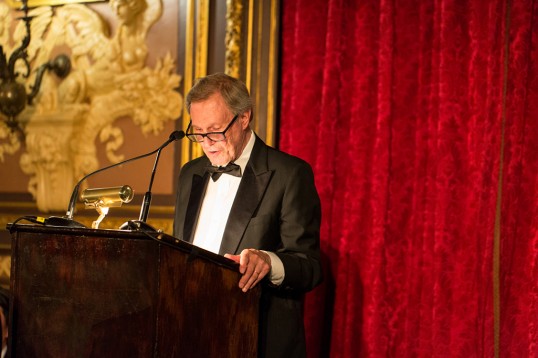President's Medal Remarks
Remarks: Neil Rudenstine
Remarks delivered by Harvard University President Emeritus Neil Rudenstine at the 2015 President's Medal dinner honoring Henry N. Cobb
On May 4, 2015, The Architectural League awarded the President’s Medal, its highest honor, to Henry N. Cobb, a founding partner of Pei Cobb Freed & Partners. The remarks that follow were delivered by Harvard University President Emeritus Neil Rudenstine at the dinner held in Cobb’s honor. Additional remarks were given by Merrill Elam, Mack Scogin, and Guy Nordenson.
It is a great pleasure and honor to be able to make some remarks about Harry Cobb. I first met Harry in the early 1970s when I was a very new and very junior administrator at Princeton University. Whether Harry was any more junior than he is now, I cannot begin to say, because so many of the qualities I saw in him then have remained — and have simply become more impressive — over the years.
My first major — and prolonged — contact with Harry came in the mid- to late-1990s, when I was at Harvard and we wanted to construct two considerable buildings — across a wide street from one another — in order to bring together in a single cluster our various international centers, institutes, programs, and similar agglomerations. Harvard is not exactly a tidy, unified place, and Harry was at the top of my list to do the job, primarily because of his extraordinary architectural capability, but also because I thought that he was likely to have the necessary combination of powerful intelligence, persuasive skills, and patience.
Why did we need these latter qualities in abundance? Well, quite apart from Harvard’s own intricacies, we had to deal with the local City Council, in all its exuberant diversity of opinion. If any of you have ever dealt with the Council, you will know why any building project that abuts the streets of Cambridge is virtually doomed before it has even begun. Let me simply say that, in less than a flash, the Council voted down the creation of a tunnel that was intended to link the two buildings under the street. Full reign was also given to the entire local neighborhood to register its punch-list of complaints: the buildings were said to be too high; they would cut off much needed light, and interfere with the views of one family or another — and these were views that, given that particular cityscape, might have been a blessing to cut off.
Harry designed two superb buildings — finely tuned structures that spoke to one another eloquently — but then the real test began, and it was to be a very long test indeed. As the client of this venture, I lost nearly all my patience very swiftly, so Harry had to play a good deal of my role, as well as his own. Quite literally years later, after countless meetings that Harry patiently held with one neighbor after another, he decided to substitute a circular top floor, rather than his original rectangular one, so that the next door dwellers could have more light and could see out their windows around the building’s curvilinear edges in order to have a less obstructed view of the sky, the street, and the local polyglot scene.
The great achievement was that the final architectural design was even better than the original: Harry had somehow imagined himself out of an impossible situation in a way that enabled him to create something more brilliant than either the obstreperous City Council or the neighborhood could possibly have conceived.
The next major experience with Harry came slightly later when, as Chairman of Princeton’s Trustee Committee on Grounds and Buildings, I led the charge to select Harry to build a new undergraduate residential college in place of a terrible “mistake of a building” that was being torn down. Here, I came to understand and deeply admire some of Harry’s other exceptional qualities. First, his sensitivity to the environment in which the new college would be placed. He deftly arranged his entire set of buildings so that they would be in line with the major horizontal and vertical walkways of the university, allowing everyone to have clear views of parts of the campus, especially the land below Harry’s college, down toward the athletic fields and finally to Princeton’s Lake Carnegie.
Then, Harry decided to use brick with limestone trim, in keeping with some nearby buildings, but very different from Princeton’s over-riding style of collegiate gothic in stone. Perhaps most of all, he designed the college in scale and placement in a way that would fully respect — and not at all compete with — a singularly important and imaginative building by Bob Venturi, which was not far from Harry’s project.
The final result was a stunning residential college, and what I learned again was that Harry could produce the best possible architecture in a way that was utterly without ego: responsive to its built environment, and — with great modesty — bowing (so to speak) to the work of other architects.
So what more can I say? We honor tonight someone who epitomizes so much of what any client could wish for: extraordinary talent, skill, deep intelligence, sensibility, and all those very rare human qualities that make him such a treasured colleague and friend.

